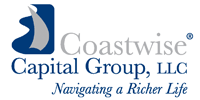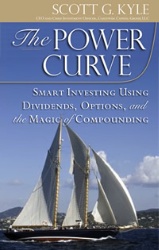Coastwise Capital Group Interview
Scott Kyle is the founder, CEO, and Chief Investment Officer of Coastwise Capital Group, a private wealth management company in San Diego. Scott has been trading covered calls for over two decades and is the author of the investment book Power Curve. Recently I had a conversation with Scott to talk about how he uses covered calls in his client accounts.

BTS (Born To Sell): Scott, thanks for taking the time today. I understand you have quite a varied background. Tell me about it.
SK (Scott Kyle): Sure. Harvard MBA, blackbelt in martial arts, and world champion sailor. But more relevant to Born To Sell readers, I've been investing with covered calls for over 20 years. I've been a professional money manager since 1997 and founded Coastwise Capital Group in 2002 as a private wealth management company. We have hundreds of separately managed accounts for high net worth individuals and families.
BTS: And you use the covered call strategy?
SK: Yes, we're a big believer in income strategies. That starts with buying dividend paying stocks and then selling call options against them.
BTS: Do you use covered calls the same way in all of the accounts you manage?
SK: No, it depends on the needs and goals of the account. For a growth oriented account we sell calls that are longer dated and further out of the money so that we leave ourselves some room for capital appreciation. In our more income focused accounts we sell shorter term calls that are closer to the current stock price, or maybe even in the money a bit.
BTS: How far out do you set the expiration date?
SK: For income accounts we're generally 30 to 60 days out. Sometimes if the market conditions, stock, and implied volatility are right we will do a weekly or two week trade. For our growth accounts we're generally 3 to 4 months out.
BTS: What kind of underlying stocks are you buying?
SK: We're a mid to large cap investor. We like high quality dividend payers like JNJ, ABT, MO, VZ, MSFT, and AAPL. We also get exposure to commodities or international via ETFs like SLV (for silver) and FXI (for China). In smaller accounts we tend more towards ETFs than individual stocks so we can get better diversification.
BTS: How many positions do you have in a typical account?
SK: Our average account is over $1M and we have around 40-50 positions. Probably 80% individual stocks and 20% ETFs. In our smaller accounts, say $250K, we'd have a much higher percent of ETFs to avoid having too many tiny stock positions.
BTS: What kind of yield do you target?
SK: It's hard to generalize because not all of our accounts have the same risk profile or goal. For example, in a growth oriented account the dividend yield could be around 2% but in an income oriented account the dividend yield could be 4%.
Normally we try to get 2x to 2.5x the dividend yield in call premium. So in an income oriented account we'd shoot for 8% to 10% from call premium, in addition to the 4% dividend yield. In a growth account we'd try to get 4% to 5% from call premium.
BTS: Do you use any margin?
SK: No. But if we have a multi-million dollar account that is 85% in stocks/ETFs and 15% in cash we might sell some naked puts where if the puts were all put to us we wouldn't have enough cash (so, technically, taking advantage of unused margin in the account). But we have systems in place such that we'd buy those puts back and/or roll to a later dated option well before we were at risk of being assigned. Once in a while we'll accept a put assignment and then turn around and sell covered calls at the same strike we were assigned.
BTS: What do you do if one of your covered calls drops significantly before expiration?
SK: It really depends on the stock and circumstances. We always start with the fundamentals. If the fundamentals have changed (gotten worse) we'll just accept the loss, sell the stock, and move on. But if the fundamentals are still good and the company happened to just miss an earnings report then we'll consider adding to the position.
For example, Walmart (WMT) dropped from 55 to 50 several times 2008 thru 2011. If we were to buy it at 55 and write a 55-strike call for $1 and then have the stock finish the option cycle at 52 with no change in the fundamentals, then we have a couple of choices. Assuming the position size isn't too big already, we could buy more at 52 and then write a 52.5 strike on the new position while leaving the original position (which has an adjusted basis of $54) uncovered while we wait for it to come back a bit. We might write a longer dated 55 strike on that first position so that we have some income while we wait for the recovery.
But one thing we don't do is roll down to a lower strike that locks in a loss if it's exercised. So, in the example I talked about, with an adjusted basis of $54 on that first lot, we wouldn't write a new option with a strike less than 54.
BTS: Do you do anything special relative to taxes? Ever buy back an in the money call so that it's not exercised (to avoid a taxable event for the stock portion)?
SK: Taxes are certainly a consideration but they're not a driver for our strategy. In a tax-deferred account (like an IRA) we can ignore them. And in a taxable account if we've had a nice 15% gain in 3 months via some combination of capital gain, dividend, and option premium then we'll probably let it get called away even if that means a short term taxable gain on the underlying stock or ETF. It's good discipline to take some profits off the table once in a while. On the other hand, if we still like the trade we might roll the option farther out to keep the trade going. Or maybe roll part of the position and let some get called away.
BTS: You've written a 250 page book called Power Curve, Smart Investing Using Dividends, Options, and the Magic of Compounding. Tell me about it.

SK: Sure. It was published in 2009 and talks about several aspects of wealth creation. I have a chapter dedicated to covered calls but it's not a covered call book per se. I also talk about how to construct a portfolio, diversification, dividends (and how to watch payout ratios for possible dividend reductions), investor psychology & emotions, etc. It's a guidebook for the style of investing we do here at Coastwise Captial Group.
BTS: What % of your clients understand the covered calls you're investing in on their behalf?
SK: Most of them understand it, although the level of understanding varies. They give us their preferences in terms of risk and account type (growth, income, etc) and we translate that accordingly into an appropriate set of investments. But they understand that by using call options for extra income we can seek to deliver better returns.
BTS: What kind of returns have you been getting?
SK: I wish I could answer that definitively but we're not running a mutual fund here. Two accounts with similar stocks could have different returns based on the account holder's preferences, the date money came in, the size of the account, the date of any withdrawals, whether one is taxable and other isn't, whether the account holder has instructed us to place trades they themselves chose, etc. All I can say is that our client retention ratio is very high and our assets under management are growing.
BTS: Thanks for your time today and best of luck to you.
SK: Thanks, Mike.
For more information on Scott's company and their separately managed accounts, please visit Coastwise Capital Group.
Disclosure: This is not an endorsement to buy or sell securities. Investing in securities carries with it very high risks. The information contained within this interview is for informational purposes only and is subject to change at any time. Do your own due diligence and consult with a licensed professional before making any investment. Born To Sell has no affiliation nor has received any compensation from anyone or any company mentioned in this interview.
Update since original interview: On Jan 16, 2013, Coastwise Capital Group was named a Five Star Wealth Manager in San Diego for the 4th consecutive year by San Diego Magazine. The Five Star list represents less than 2% of the wealth managers in San Diego, and candidates are nominated by peers and other firms including wealth managers, CPAs, attorneys, etc. Congrats!
Mike Scanlin is the founder of Born To Sell and has been writing covered calls for a long time.
